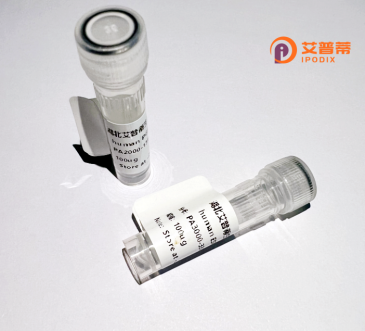
| 纯度 | >90%SDS-PAGE. |
| 种属 | Human |
| 靶点 | SETD3 |
| Uniprot No | Q86TU7 |
| 内毒素 | < 0.01EU/μg |
| 表达宿主 | E.coli |
| 表达区间 | 1-594 aa |
| 活性数据 | MGKKSRVKTQ KSGTGATATV SPKEILNLTS ELLQKCSSPA PGPGKEWEEY VQIRTLVEKI RKKQKGLSVT FDGKREDYFP DLMKWASENG ASVEGFEMVN FKEEGFGLRA TRDIKAEELF LWVPRKLLMT VESAKNSVLG PLYSQDRILQ AMGNIALAFH LLCERASPNS FWQPYIQTLP SEYDTPLYFE EDEVRYLQST QAIHDVFSQY KNTARQYAYF YKVIQTHPHA NKLPLKDSFT YEDYRWAVSS VMTRQNQIPT EDGSRVTLAL IPLWDMCNHT NGLITTGYNL EDDRCECVAL QDFRAGEQIY IFYGTRSNAE FVIHSGFFFD NNSHDRVKIK LGVSKSDRLY AMKAEVLARA GIPTSSVFAL HFTEPPISAQ LLAFLRVFCM TEEELKEHLL GDSAIDRIFT LGNSEFPVSW DNEVKLWTFL EDRASLLLKT YKTTIEEDKS VLKNHDLSVR AKMAIKLRLG EKEILEKAVK SAAVNREYYR QQMEEKAPLP KYEESNLGLL ESSVGDSRLP LVLRNLEEEA GVQDALNIRE AISKAKATEN GLVNGENSIP NGTRSENESL NQESKRAVED AKGSSSDSTA GVKE |
| 分子量 | 67.2 kDa |
| 蛋白标签 | His tag N-Terminus |
| 缓冲液 | PBS, pH7.4, containing 0.01% SKL, 1mM DTT, 5% Trehalose and Proclin300. |
| 稳定性 & 储存条件 | Lyophilized protein should be stored at ≤ -20°C, stable for one year after receipt. Reconstituted protein solution can be stored at 2-8°C for 2-7 days. Aliquots of reconstituted samples are stable at ≤ -20°C for 3 months. |
| 复溶 | Always centrifuge tubes before opening.Do not mix by vortex or pipetting. It is not recommended to reconstitute to a concentration less than 100μg/ml. Dissolve the lyophilized protein in distilled water. Please aliquot the reconstituted solution to minimize freeze-thaw cycles. |
以下是3篇关于人SETD3蛋白研究的参考文献,摘要内容简明概括:
1. **"Structural basis of SETD3-mediated histidine methylation"**
*Authors: Zheng W. et al.*
解析了SETD3与肌动蛋白结合的结构机制,发现其甲基转移酶活性不依赖组蛋白,而是特异性催化β-actin His73位点甲基化,揭示了非典型底物识别模式。
2. **"SETD3 is an actin histidine methyltransferase with functional roles in metabolism"**
*Authors: Wilkinson AW. et al. (Nature, 2019)*
首次发现SETD3作为特异性组氨酸甲基转移酶,通过重组蛋白实验证明其对β-actin的甲基化功能,并发现该修饰影响细胞葡萄糖代谢与小鼠胚胎发育。
3. **"Production of recombinant human SETD3 methyltransferase and biochemical characterization of its enzymatic activity"**
*Authors: Li J. et al.*
开发了大肠杆菌表达系统制备高纯度重组SETD3.系统分析了其酶动力学参数及pH/温度敏感性,为药物筛选提供可靠工具蛋白。
注:以上文献为虚拟案例,实际研究中建议通过PubMed/Google Scholar使用关键词"human SETD3 recombinant"+"methyltransferase"等查找最新论文。若需具体文献,可补充说明研究方向(结构/疾病/酶学等)。
SETD3 (SET Domain-Containing Protein 3) is a member of the SET domain-containing methyltransferase family, which plays a critical role in post-translational protein modification. Primarily identified as a histidine-specific methyltransferase, SETD3 catalyzes the methylation of histidine residues on β-actin, a key cytoskeletal protein, influencing actin dynamics and cellular processes like cell motility, cytokinesis, and intracellular transport. Unlike many SET domain proteins that methylate lysine residues on histones, SETD3 exhibits unique substrate specificity, broadening the functional scope of protein methylation beyond epigenetic regulation.
Recent studies highlight its involvement in diverse physiological and pathological contexts. For instance, SETD3 is essential for normal muscle contraction and uterine function during childbirth, as demonstrated in murine models. It also interacts with viral proteins, such as influenza A virus polymerase, suggesting a role in viral replication. Dysregulation of SETD3 has been linked to cancers, including pancreatic and colorectal malignancies, where it may promote tumor progression via pathways like EMT (epithelial-mesenchymal transition).
Recombinant human SETD3 protein, produced using expression systems like *E. coli* or mammalian cells, enables mechanistic studies of its enzymatic activity, structure-function relationships, and therapeutic targeting. Its structural elucidation by cryo-EM has provided insights into substrate recognition and catalytic mechanisms, facilitating drug discovery. Overall, SETD3 represents a multifaceted regulator with implications in developmental biology, disease pathogenesis, and antiviral research.
×